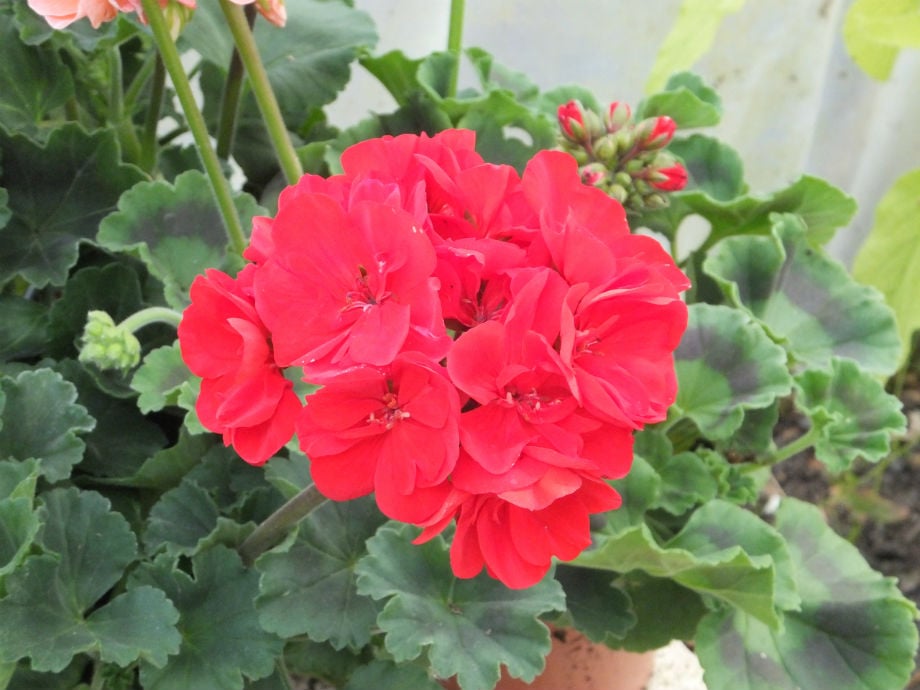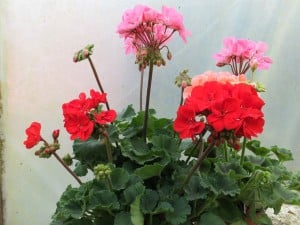
This greenhouse family gives us surprisingly tough house and conservatory plants, also loved as outdoor summer bedding and happy in fairly cramped containers. These have gorgeous flowers and beautiful foliage year round in a bewildering range of colours. With different leaf shapes and patterns, even trailing varieties, many are scented and some can be used in the kitchen. So what are these?
Clue- if you grow a dozen of the scarlet variety in terracotta pots, place them in front of a sunny whitewashed wall or running up the steps of an outside staircase you create an intensely Mediterranean theme.
This is the good old scarlet geranium, so evocative of warmer days, it’s known to gardeners, even schoolchildren, everywhere. Despite being a tender plant this survives neglect much like a cactus often surviving into a surprising old age half-forgotten on some windowsill. Yet given good conditions what a recovery and display such a poor old specimen can become.
Of course the scarlet geranium should now be known as a zonal pelargonium (the zonal refers to the patterned leaf). The true geraniums are several closely related hardy plants we would place in woodland edge or shady borders.
First discovered in South Africa in the early sixteen hundreds some species of this large genus of Pelargonium soon proved popular and spread worldwide becoming crossed and hybridised along the way. Indeed some naturalised to the point of becoming weeds in frost free regions.
 The original species make for interesting collection with some closely resembling cacti, even to the spines. But more valuably there are many modern hybrids which are very decorative. The well-known original ‘geranium’ sorts now come in a huge range of flower colours many also with bronze or golden foliage. The regal series are particularly vibrant. Popular in middle Europe we get ivy leaved and trailing sorts good for hanging baskets or tubs on a patio or balcony. Then there are numerous scented leaf varieties coming with rose, pine, eucalyptus, violet, peppermint, orange, lemon, ginger variations etc. Most of these can be used (in moderation) to flavour desserts, sorbets, beverages and dried for pot-pourris.
The original species make for interesting collection with some closely resembling cacti, even to the spines. But more valuably there are many modern hybrids which are very decorative. The well-known original ‘geranium’ sorts now come in a huge range of flower colours many also with bronze or golden foliage. The regal series are particularly vibrant. Popular in middle Europe we get ivy leaved and trailing sorts good for hanging baskets or tubs on a patio or balcony. Then there are numerous scented leaf varieties coming with rose, pine, eucalyptus, violet, peppermint, orange, lemon, ginger variations etc. Most of these can be used (in moderation) to flavour desserts, sorbets, beverages and dried for pot-pourris.
You can grow many sorts from seed with little difficulty (some bottom heat helps) and almost all can be propagated by cuttings (as seen so often on TV gardening programs).
Contrary to common belief most pelargoniums don’t need poor soil but reasonably rich ones, and to be lightly fed as well. However too much feed, especially Nitrogen, causes lusher growth and loses the desired colouring and patterning. Watering is another misconception, although pelargoniums can endure drought for long, they flower and look better with an adequate regular supply. Naturally this is reduced to minimum from autumn through winter as growth slows and slowly increased again in spring.
Pelargoniums generally prefer warmth and light but do not need to be baked and parched as if in their native desert. Such severe conditions may encourage red spider mite. It’s better to keep them well ventilated even a tad humid during the summer. In winter aridity is safer as its mould not cold that kills. Scrupulous tidying of dead leaves etc. helps keep them safe. Otherwise they’re seldom any trouble, indeed just too easy.


